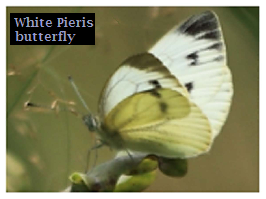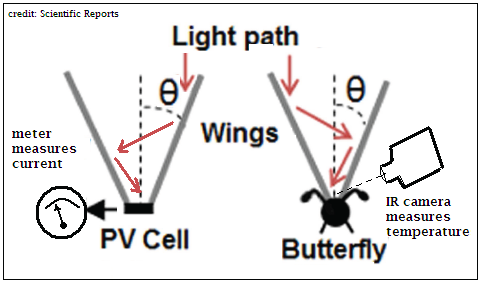Butterfly wings are showing the way to improve solar cell performance, says S.Ananthanarayanan.
With the conversion efficiency of solar cells not rising above 20%, getting more light to fall on solar cell panels is a way to make the better use of this source of green power. The best way to do it, so far, has been with conical reflectors which funnel sunlight, but the arrangement is bulky and adds to weight of the device. The discovery that a species of butterfly uses its wings to concentrate sunlight to prime its muscles for take-off suggests that the process could be mimicked in solar panels.
Katie Shanks, S. Senthilarasu, Richard H. ffrench-Constant and Tapas K. Mallick, at the University of Exter, in the UK, describe in the Scientific Reports, a journal of the Nature group, their study of white butterflies of the family, Pieridae, whose wings have surface nanostructure that has evolved for the most efficient reflection of the relevant band of frequencies.

Solar Cells
The atoms of solar cell material have loosely bound electrons that can be knocked out by the energy of a photon of light. This causes a buildup of charges at the surface, and if the charges are whisked away through a one-way circuit, there is an electric current, which can charge a battery, and the atoms of the material are ready to put out more electrons, and so on. As what solar cells need is just light, even scattered light, not necessarily direct sunlight, they are effective even on days that are cloudy or overcast. However, for the actual conversion of light energy to electricity, it is not every photon that strikes the photovoltaic material that leads to an electron being pumped out. A large proportion of the photons get reflected, or transmitted or absorbed, only to warm up the solar cell, and only a fraction lead to generation of electricity. Hence the concern to make sure that as much light as possible gets to strike the cells.
The way ‘lightfall’ is maximised, or concentrated in solar cell panels, the University of Exter paper observes, is with the help of mirrors and lenses. The concentrators are tyically a V-shaped pair of reflectors, either of polished metal or reflective film or polymer coatings on plastics or even vacuum metalising on suitable surfaces. But these methods all have limitations, of the choice of materials, how well the materials can be shaped, and, most of all, in the case of the most effective solutions, of the weight. While the reflectance of the surface is important, what is often vital is the power-to-weight ratio. There has thus been great interest in finding a lightweight material that can be easily applied and shaped, the paper says
Butterfly wings
An instance in the natural world of specifically concentrating solar radiation has been observed in the case of the white butterflies of the genus Pieris. Butterflies need to conserve weight, and apart from lightweight wings, they also conserve muscular resources, which need to be warmed before they can propel the wings for flight, especially when the weather is cooler. As butterflies are cold blooded, they hence need external heat, like heat of sunlight, to be able to get started. Here, it has been seen that on cloudy days, when there is less direct sunlight, the White Pieris is able to take to flight before other species.

The Exter paper notes that this abliity has been related to the ‘V’ shaped wing position that the White Pieris adopts, a behaviour the authors like to call, ‘reflectance basking‘’. They note that the high reflectance of the wings has been recorded in other studies, which have found specific patterns of beads, which contain the compound, ‘pterin’, on the wings.It has even been shown that removing these beads from the wing surface promptly reduces the reflectance of the wings by a third. The arrangement of pterin beads on the wings also shows a ‘quasi-random’ pattern, the authors say, and this kind of arrangement has been recently found to help use interference effectsof light to concentrate light over a range of freqjuencies.
The Exter group hence undertook detailed investigation into the mechanism of the butterfly wing concentator, with a view to developing a related method for application in solar cells. They first checked whether the wings did, in fact, concentrate warmth on the thorax, the relevant body part of the butterfly. And then, wether there was a particular angle of the ‘V’, which could be adopted for use in solar cells.And next, did the wings also serve to concentrate optical frequencies, which would be of use in solar cells? And finally, could the whole butterfly wing or parts of the wing, like a layer of removed scale cells or an imitation, be used directly to improve the working of solar cells?

The results of the trials were that while the wings did positively concenrate heat at the thorax of the butterly, the use of butterfly wings, held at the correct angle, also concentrated visible light and did substantially increase the efficiency of photovoltaic, ie solar cells. On carrying out a survey of different butterfly wings, it was found that the forewing of the large white butterfly was the most effective and a whole wing attached to a 1 cm square solar cell increased its output by 42.3%. And given the low weight of the wings, the improvement of the power to weight ratio was a dramatic 17-fold increase. And what is more, it was found that even a single cell layer peeled off the wing, on to a strip of adhesive tape, resulted in the full high reflectance. This allays the reservation that had been expressed, that it was perhaps the actual complex structure of butterfly wings that brings about their action. That a mono-layer is equally effective suggests that such a layer could be used as an even lighter weight concentrator for solar cells.
Quasi random
The action of the butterfly wing in concentrating all frequencies of light in the range that affects solar cells appears to arise from the way the Pterin beads are arraged on the surface. A regular, repeating pattern of rulings or other patterns on a reflecting surface gives rise to multiple waves of light from each ruling or, in this case, the Pterin beads. Light from the different reflecting points would then reach other places in the form of waves at different stages of wave motion, and they would reinforce at some places or anihilate at other places. A regular pattern, at the scale of the wavelength of light waves, would then act to concentrate particular wavelengths of light but not all wavelengths.A random arrrangement, without any pattern, on the other hand, would not select frequencies, and the surface would be reflective in all directions, and not concentrate light at any place. A third possibility is a ‘‘quasi-random‘’, or ‘‘quasi-periodic‘’ pattern. This kind of pattern has a ‘long-range‘’ periodicity and the effect is that it can select not specific frequencies, but a range of frequencies – which is exactly what is relevant for the concentrator for solar cells. Creating such patterns at the dimensions of the frequency of light waves, on any commercial scale, would be quite impractical. But it is fascinating that the forces of evolution, over the millions of years that butterflies have been around, have fashioned these patterns on the White Pieris butterfly wings, which happen to to be just right for use with solar cells!
Apart from the clear value,in bringing about 43.3% improvement in the output and a 17-fold increase in power-to-weight ratio, the authors of the paper also observe that the arising of the quasi-random pattern “supports the idea that any given problem may first have been solved by nature.” While butterflies are now providing us with a way to improve solar cell performance and tackle global warming, it is ironic that global warming is busy wiping out biodiversity and driving species extinct – and infinite riches of technological evolution with them.
Blue Ray compact disk
The value of the quasi –random pattern in light manipulation in a range of frequencies, with application for solar cells, was reported by a group from North Western University, Illinois in 2014. The group reported that the sequence of ‘pits’ and ‘lands’ (ie, no pit) that as engraved on Blue Ray discs forms a pattern that has quasi-random character
Blue Ray is the latest convention for coding compac discs and uses indentations that are of the dimensions of the wavelength of visible light. There is elaborate coding, with error detection devices, etc., which destroys the regular, periodic character of the original matter. However, the pattern is not entirely random and appears to retain the ‘long range’ periodicity that makes for resonnance with a range of frequencies.
Creating a ‘quasi-random’ sequence, with indents of the correct dimensions, for use with solar cells, is impractical. However, as Blue Ray discs are mass produced, they may turn out to be the inexpensive solution. There does not appear to be a study, as yet, of how butterfly wings and Blue Ray discs may compare in practice
------------------------------------------------------------------------------------------